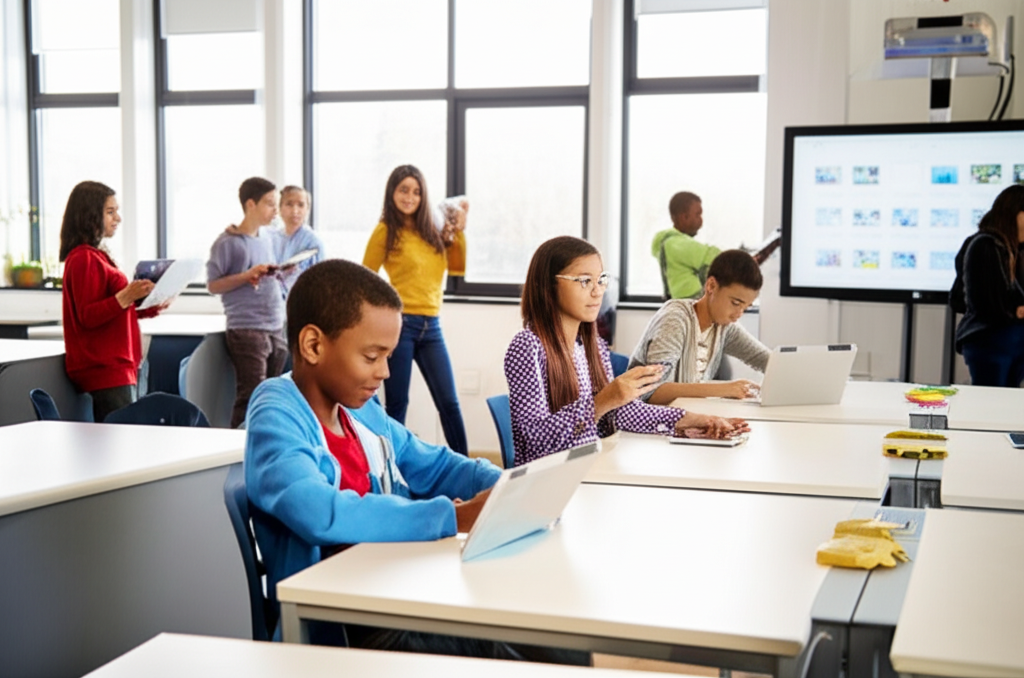
Table of Contents
Introduction
Imagine walking into a classroom where traditional chalkboards and textbooks blend seamlessly with interactive screens and smart devices, creating an environment where learning becomes engaging and dynamic. Technology integration in classrooms is no longer a futuristic ideal but a present-day reality transforming the way students engage with knowledge and skills. This powerful fusion of technology and education is reshaping learning experiences, making education more personalized, accessible, and effective for diverse learners.
In today’s rapidly advancing digital era, classrooms equipped with technology tools offer vast possibilities for educators and students alike. Studies show that schools adopting digital tools see increased student participation and motivation, which directly impacts academic performance. By fostering collaboration, stimulating creativity, and providing instant access to vast information, technology serves as a catalyst for deeper understanding. These innovations are crucial not only for academic growth but also for preparing students to thrive in a technology-driven world.
However, the journey to effective technology integration is complex. It involves thoughtful implementation, addressing challenges such as teacher training, budget constraints, and equitable access for all students. The real value of integrating technology lies in its ability to enhance—not replace—the critical role of educators in nurturing curiosity and critical thinking. When done right, this integration supports differentiated instruction tailored to individual learning styles and paces, fostering inclusivity.
As classrooms evolve from static spaces of rote learning to vibrant hubs of interactive discovery, educators must adapt alongside students. Understanding how to harness technology’s full potential is key to cultivating an engaging educational environment that prepares learners for future challenges. This guide offers insights into how technology is transforming classrooms, highlighting practical tools, benefits, challenges, and successful strategies for integration that empower both teachers and students.
What You’ll Learn in This Guide
This comprehensive guide explores the multifaceted impact of technology in classrooms and provides actionable advice for educators and administrators aiming to enhance learning experiences through digital means. Here’s what you can expect to learn:
- Benefits of Technology Integration: Understand the key advantages including improved student engagement, personalized learning opportunities, and access to diverse educational resources that transform traditional teaching methods.
- Essential Tools and Technologies: Discover common hardware and software tools like tablets, interactive whiteboards, learning management systems, and educational apps that facilitate interactive and collaborative learning environments.
- Challenges and Solutions: Recognize common obstacles such as budget limitations, technical issues, and resistance to change, along with practical strategies to overcome these barriers for successful implementation.
- Effective Integration Strategies: Learn best practices including careful planning, ongoing teacher training, robust technical support, and innovative student engagement techniques that optimize technology use and improve educational outcomes.
Throughout this guide, you’ll gain a clear understanding of how classroom technology can enhance both teaching and learning. Whether you are a teacher exploring ways to enrich your lessons or a school leader planning digital initiatives, this information will help you make informed decisions and confidently adopt technology in your educational context.
We will delve into various technology tools currently shaping classrooms, from interactive whiteboards to learning management systems such as Google Classroom, which streamline resource management and student communication. You’ll also explore the multitude of benefits technology offers—from boosting comprehension through multimedia content to facilitating collaboration and differentiated instruction tailored to student needs.
Moreover, this guide addresses the practical considerations and challenges schools face during integration. From budgetary constraints to technical infrastructure and human factors like teacher readiness and student access equity, we cover key points that affect success. Importantly, you’ll find recommendations on how to navigate these challenges with well-planned strategies and ongoing support systems.
By the end of this introduction and subsequent sections, you will be equipped with both inspiration and concrete guidance on harnessing the potential of technology in education. Embracing these advancements can transform classrooms into vibrant, effective learning spaces where every student has the opportunity to succeed and thrive. Let’s embark on this journey to unlock the future of education together.

Building on the introduction of technology’s transformative role in classrooms, it is essential to delve deeper into the specific benefits and the array of tools that facilitate this integration. Technology has revolutionized the educational landscape, not just by making lessons more dynamic but by tailoring learning experiences to meet individual student needs. The continued evolution of digital resources, alongside classroom hardware, creates vast opportunities for both educators and students to engage more effectively. As classrooms embrace these digital tools, the focus shifts towards understanding how these benefits manifest and which technologies are essential for successful implementation.
Benefits of Technology Integration in Classrooms
Integrating technology in classrooms has become a pivotal strategy for boosting student engagement, enhancing academic performance, and supporting educators in delivering effective instruction. The advantages run deep beyond just modifying the teaching environment; technology enables personalized learning paths, allowing students to progress at their own pace and according to their unique learning styles. Additionally, interactive digital tools improve comprehension and retention, transforming passive learning into active exploration. Teachers gain valuable capabilities through technology, including streamlined lesson planning, efficient resource management, and real-time assessment feedback, making instruction more responsive and dynamic.
Moreover, technology fosters collaboration among students by providing platforms where they can share ideas and work on projects seamlessly, regardless of physical location. This increased connectivity not only enhances learning but also prepares students for the collaborative nature of modern workplaces. For educators, the accessibility of online professional development widens horizons, keeping them updated on best practices and innovations. To fully grasp this topic, it helps to consider related concepts such as technology and artificial intelligence, which are reshaping educational tools.
Key Aspects of Benefits of Technology Integration in Classrooms
The multifaceted benefits of technology integration can be broken down into key areas impacting both students and teachers significantly:
- Increased Student Engagement: Interactive whiteboards, educational apps, and multimedia content capture students’ attention more effectively than traditional methods. This engagement is crucial for deeper understanding and motivation.
- Personalized Learning Opportunities: Adaptive software analyzes student performance and adjusts difficulty or content delivery, catering to individual strengths and weaknesses for better outcomes.
- Enhanced Collaboration: Tools like online discussion boards and shared digital workspaces enable students to collaborate in real-time, fostering teamwork and communication skills.
- Teacher Efficiency and Feedback: Technology streamlines lesson preparation and provides immediate feedback through assessment tools, allowing educators to adjust teaching strategies promptly to meet student needs.
Essential Tools and Technologies Used in Classroom Integration
To reap the full benefits of technology integration, schools must adopt a variety of tools tailored to their instructional goals. The hardware and software components must work in harmony to create a conducive learning environment. Interactive whiteboards and projectors bring lessons to life visually, while laptops and tablets empower students to engage directly with learning materials. Meanwhile, document cameras and audio systems ensure that content is accessible and clear to all learners. These hardware elements form the physical backbone of classroom technology.
On the software side, learning management systems (LMS) like Google Classroom centralize assignments, grading, and communication, making it easier for teachers to manage their classrooms and for students to stay organized. Subject-specific educational apps enhance skills development and allow for targeted practice. Real-time quiz and assessment applications offer immediate insights into student understanding, enabling more responsive teaching. For those keen to explore current digital innovations in education, reviewing the latest technology trends of 2025 provides valuable context on emerging tools shaping classrooms.
Important Considerations for Essential Tools and Technologies
When selecting and implementing technology in classrooms, several key points should be considered to maximize effectiveness and usability:
- Hardware Reliability and Accessibility: Devices such as tablets and interactive boards must be durable, user-friendly, and accessible to all students to ensure equitable learning experiences.
- Integration with Curriculum: Software and applications should align with curricular goals and support differentiated instruction to meet diverse student needs effectively.
- Teacher Training and Support: Successful technology use depends on teachers feeling competent with the tools; therefore, ongoing professional development and technical support are essential.
- Security and Privacy: Educational technologies must adhere to strict data privacy standards to protect student information and maintain trust within the school community.

